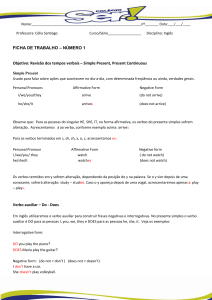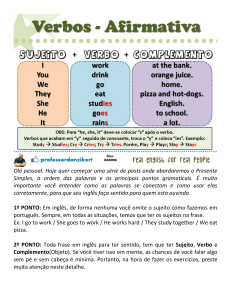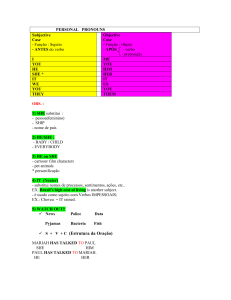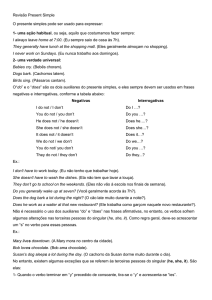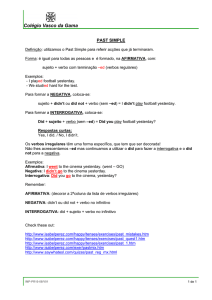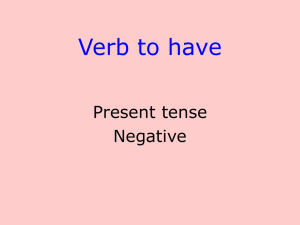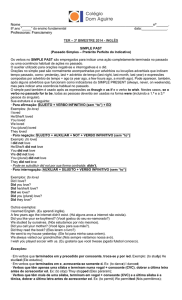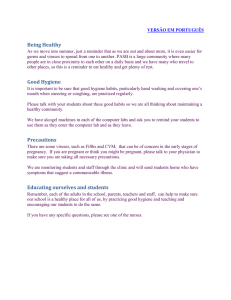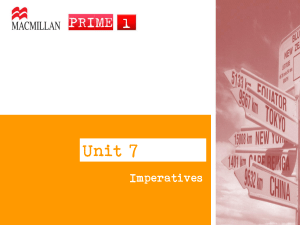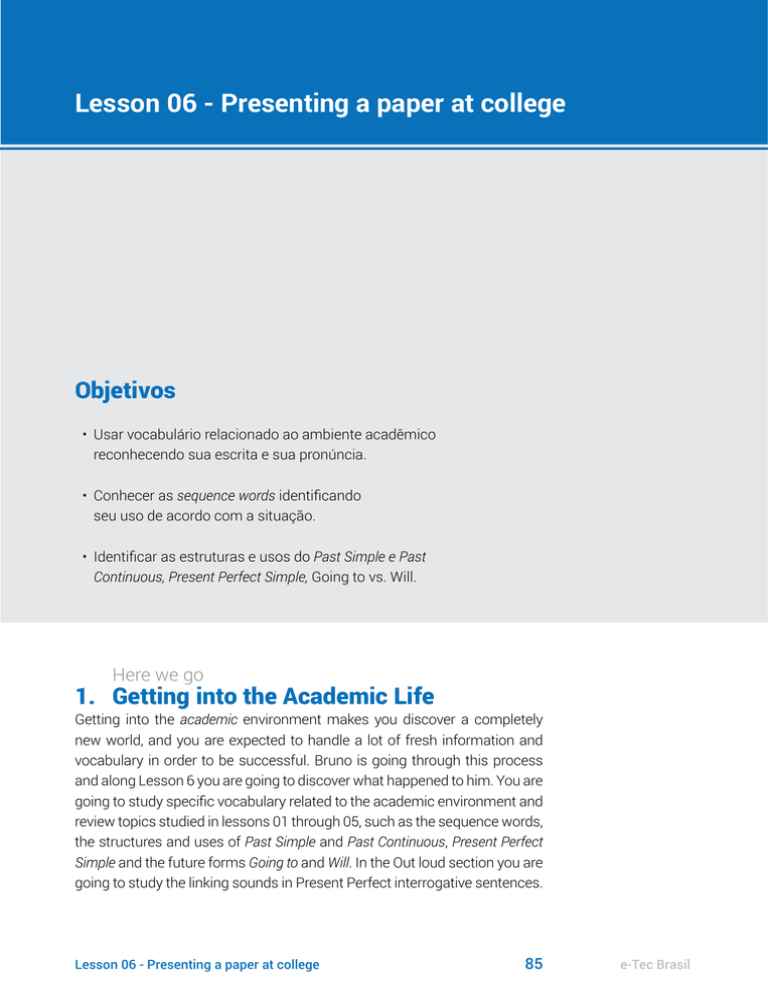
Lesson 06 - Presenting a paper at college
Objetivos
• Usar vocabulário relacionado ao ambiente acadêmico
reconhecendo sua escrita e sua pronúncia.
• Conhecer as sequence words identificando
seu uso de acordo com a situação.
• Identificar as estruturas e usos do Past Simple e Past
Continuous, Present Perfect Simple, Going to vs. Will.
Here we go
1. Getting into the Academic Life
Getting into the academic environment makes you discover a completely
new world, and you are expected to handle a lot of fresh information and
vocabulary in order to be successful. Bruno is going through this process
and along Lesson 6 you are going to discover what happened to him. You are
going to study specific vocabulary related to the academic environment and
review topics studied in lessons 01 through 05, such as the sequence words,
the structures and uses of Past Simple and Past Continuous, Present Perfect
Simple and the future forms Going to and Will. In the Out loud section you are
going to study the linking sounds in Present Perfect interrogative sentences.
Lesson 06 - Presenting a paper at college
85
e-Tec Brasil
Warming up
2. Bruno’s presentation
Bruno is presenting his paper to some faculty members and students
at the university. This is a very important moment in his academic life,
but he gets a little distracted by his cell phone. Professor Campbell is
his advisor, so he gives Bruno some instructions. Read and listen to
Bruno’s presentation.
Bruno: Good morning! It’s very good to see you all here today. To begin with, I’d
like to thank my advisor, Professor Campbell, who has welcomed me so warmly.
I’d also like to thank my Brazilian professors, who have always supported and
Integrated media
Clique na mídia Bruno’s
presentation e assista o
momento em que Bruno inicia
sua apresentação na disciplina
do professor Campbell.
motivated me. I’ll start my presentation by saying... saying that this article is just
an excerpt of the research I have worked on, about the use of technologies and
language teaching. It focuses on... It focuses on... this article aims to promote a
discussion about the use of social medias in foreign language teaching.
Professor: Very good, Bruno. I’d like to say it’s a pleasure for us to have a
Brazilian student in our university. Besides, the subject of your research seems
very interesting.
Bruno: Thank you, Professor Campbell. I...
Professor: So... you now have twenty minutes for your presentation. After that we’ll
have ten minutes for questions.
Bruno: Thank you, Professor Campbell. So, I’ll start talking about...
In his presentation, Bruno uses the words article and research, referring
to his studies. In the following topic, you are going to study more words
related to the academic environment.
e-Tec Brasil
86
English
3. Getting the hang of it
3.1 Academic vocabulary
A rotina acadêmica envolve algumas palavras específicas, como você
pode ter percebido na fala de Bruno. Veja a seguir algumas delas:
Audio
Essay
A short piece of writing about a subject, especially written
by a student. It’s usually five-paragraph long.
Glossary
Essay: redação; ensaio
Paper: trabalho; exame; artigo
Article: artigo
Lecture: palestra
Theoretical framework:
enquadramento teórico
Quotation: citação
Audience: plateia
Paper
A written assignment, longer than an essay, averaging eight pages in length.
It can also mean a part of an examination.
Field of study
The specific area of a subject in which you concentrate your research and study.
Abstract
A short text with the main information of a thesis or dissertation.
Keywords
The keywords are the most important words of a thesis or dissertation.
Article
A piece of writing on a newspaper or magazine.
Plagiarism
The act of not mentioning the source of your information,
making it sound like it’s your own.
Lesson 06 - Presenting a paper at college
87
e-Tec Brasil
Lecture
A talk given to a group of people - on an academic or
random topic, which is open to the community.
Audio
Theoretical framework
The structure that supports a theory of a research study.
Quotation
A sentence (or more than one) taken from a book, poem or play. In
academic writings, it always comes between quotation marks.
Source
It’s where you got the information from: author’s full name, name
of the book, year of publication and page. In case you used a
webpage, put the valid electronic address in your work.
Dissertation
A dissertation is a piece of writing on a subject, contrasting existing ideas or theories.
Audience
The people who attend your lecture or presentation.
Thesis
A piece of writing to be discussed and defended based on hypothesis or
theoretical assumptions. In general, a thesis presents a new theory.
Reference
All the books, magazines and different sources you
used to produce your thesis or dissertation.
Learning activity
Talking about academic works
Discussing academic subjects
e-Tec Brasil
Conhecer este vocabulário é importante para que você consiga se
comunicar em situações no meio acadêmico. Desta forma, realize as
atividades Talking about academic works e Discussing academic subjects.
No tópico a seguir, você estudará sequence words, que o ajudarão a
organizar os fatos a serem relatados de forma clara e lógica.
88
English
3.2 Sequence words
Bruno apresentou um trabalho sobre o uso das tecnologias e o ensino de
línguas. Para que sua apresentação tivesse um bom encadeamento e a
plateia pudesse acompanhar seu raciocínio, ele utilizou algumas sequence
words. Observe que:
•
Audio
Para expressar o que vai dizer primeiro, ele usa To begin with:
To begin with I’d like to thank my advisor, Professor Campbell…
• Para expressar o que vai dizer no início de sua apresentação, ele diz:
I’ll start my presentation by saying...
•
Para expressar em que área está concentrada sua apresentação,
ele utiliza:
It focuses on…
•
Para expressar o objetivo de seu trabalho, ele diz:
This article aims to promote...
Lesson 06 - Presenting a paper at college
89
e-Tec Brasil
Ao terminar sua apresentação, a plateia ficou bastante entusiasmada para
fazer perguntas e discutir o assunto com Bruno. Veja o que Alvin, um
colega contrário ao uso de tecnologias, disse:
Alvin: I’m sorry, Bruno. First of all, I’m not sure it is so helpful to use technology
to teach a foreign language. I wrote an article about social medias, it has the
behaviorist approach as a theoretical framework. Based on my experience with
Integrated media
Acesse a mídia Alvin’s comment
para escutar este texto.
undergraduate students, I can say that social medias may disturb the learning
process. As a final remark, I’d like to say that technology won’t make a good class,
but a hardworking and resourceful teacher.
Glossary
First of all: antes de mais nada
Based on: baseado em
As a final remark : como
último comentário
Learning activity
Perceba que o colega de Bruno estabeleceu o encadeamento de sua fala
de outra forma. Ele utilizou First of all e As a final remark para destacar a
sequência de seu texto.
Conhecer as sequence words permite que você consiga indicar a ordem em
que algo acontece. Neste momento é importante praticar este conteúdo
realizando a atividade Rearranging a presentation.
Rearranging a presentation
Após exercitar esse conteúdo, revise a estrutura do Past Simple e Past
Continuous no tópico a seguir.
e-Tec Brasil
90
English
3.3 Past simple vs. Past continuous - Structure
No episódio desta aula, Carlton está caminhando pela rua e encontra o
mendigo que fingiu ser seu pai no falso funeral. Na tentativa de descobrir
a verdade, ele o confronta:
Audio
You pretended to be my father!
O mendigo se defende, e explica o que aconteceu:
I was just looking for some money and food.
A partir destes dois exemplos, você revisará a estrutura e uso do Past
Simple e Past Continuous. Acompanhe a tabela a seguir:
Past Simple
Past Continuous
Descreve fatos ou fala de ações finitas
que iniciaram e terminaram no passado.
Descreve ações em
andamento no passado.
Para estruturar as affirmative sentences nestes dois tempos verbais é
preciso obedecer às seguintes estruturas:
I came here a few days ago
and saw this beautiful girl.
Past
Simple
Verbo principal no
passado (regular
ou irregular):
Carlton traveled to Canada by plane.
Your presentation was
excellent, Bruno.
Getting on
Acesse Time Expressions para retomar este conteúdo
que foi abordado na aula
14 do Módulo 1.
You were at the funeral yesterday!
Past
Continuous
Verb To be (past)
+ verbo principal
no gerúndio:
Lesson 06 - Presenting a paper at college
The audience were waiting
for Bruno’s presentation.
Mind the gap
Para substantivos coletivos,
como por exemplo audience,
police, family e team, utilizamos
o verbo To be no plural, já que se
trata de mais de uma pessoa.
Professor Campbell was
recording Bruno’s presentation
for future reference.
91
e-Tec Brasil
Para formar as negative sentences, obedecemos às seguintes estruturas
nestes dois tempos verbais:
Audio
Negative sentences
Past
Simple
Past
Continuous
É acrescentado o auxiliar
did e a partícula de
negação not. O verbo
principal se mantém
na forma infinitiva.
Esta estrutura é
usada para todas as
pessoas (sujeito).
Verb To be (past) +
not + verbo principal
no gerúndio. É
possível a contração
To be (past) + not:
I didn’t know that.
Bruno didn’t answer
Carlton’s phone call.
Sarah wasn’t working that day.
Some of Bruno’s classmates
weren’t paying attention
to his presentation.
As interrogative sentences obedecem às seguintes estruturas nestes dois
tempos verbais:
Interrogative sentences
Past
Simple
Auxiliar did antes do
sujeito e verbo principal
na forma infinitiva:
Past
Continuous
Verb To be (past) antes
do sujeito + verbo
principal no gerúndio:
Hey, did you say diner?
Did he talk to Carlton after
the presentation?
Was Bruno presenting
his paper yesterday?
Were Sarah and Amélie working?
Já as short answers, nas formas afirmativas e negativas, obedecem às
seguintes estruturas. Veja na tabela:
e-Tec Brasil
92
English
Short answers
Yes, I did.
Affirmative - auxiliar
did para todas as
pessoas (sujeito):
Past
Simple
Negative - auxiliar
did + not para
todas as pessoas
(sujeito). Pode haver
contração did + not:
No, he didn’t.
No, they didn’t.
Yes, he was.
Affirmative - verb
To be (past):
Past
Continuous
Yes, they were.
No, she wasn’t.
Negative - verb To
be (past) + not. Pode
haver contração verb
To be (past) + not:
Para formar perguntas
seguintes estruturas:
com
as
Audio
Yes, he did.
No, they weren’t.
Wh-questions
obedecemos
as
Wh-questions
Past
Simple
O pronome interrogativo
é incluído no início
da pergunta:
O pronome interrogativo
é incluído no início
da pergunta:
What did you do last night?
Where did he go yesterday?
Why was she talking to her boss?
What were you doing at 5 o’clock?
A partir desta retomada sobre as estruturas do Past Simple e Past
Continuous, teste sua aprendizagem realizando as atividades The use and
structure of Past Simple e Use and structure of Past Continuous.
Você retomará, a seguir, o Past Simple e o Past Continuous observando as
diferenças de uso e também as conjunções de tempo when e while.
Lesson 06 - Presenting a paper at college
93
Learning activity
The use and structure
of Past Simple
Use and structure of
Past Continuous
e-Tec Brasil
3.4 Past Simple vs. Past Continuous Uses
Audio
O Past Continuous é utilizado juntamente com o Past Simple para expressar,
respectivamente, a ação que estava em andamento e o que causou uma
interrupção. Podemos utilizar as conjunções de tempo when (+ subject +
Past Simple) ou while (+ subject + Past Continuous). Observe os exemplos:
SUBJECT + PAST SIMPLE
WHILE
SUBJECT + PAST CONTINUOUS
Carlton called Bruno
while
he was presenting his paper.
SUBJECT + PAST CONTINUOUS
WHEN
SUBJECT + PAST SIMPLE
Carlton called Bruno
while
he was presenting his paper.
Nos exemplos anteriores, when e while estão no meio da frase. Mas essas
conjunções também podem estar no início dela, sem alteração de sentido.
Perceba que, quando when ou while iniciam a frase, é necessário colocar
uma vírgula após a primeira oração. Veja nos exemplos:
While Bruno was presenting his paper, Carlton called him.
When Carlton arrived at the diner, Amélie was working.
Learning activity
Entender as diferenças de uso do Past Continuous e Past Simple é importante
para que você consiga se comunicar de forma adequada. A partir deste
conteúdo é possível realizar a atividade Past Simple vs Past Continuous.
Past Simple vs Past Continuous
No tópico a seguir você poderá revisar a estrutura do Present Perfect
Simple, relembrando como formar frases afirmativas, interrogativas,
negativas e respostas curtas.
e-Tec Brasil
94
English
3.5 Present Perfect Simple Structure
No episódio desta aula, Carlton descobre que Sarah trabalha em uma
lanchonete. Carlton vai até lá, mas nesse dia Sarah não está trabalhando.
Amélie, sua colega, lhe dá algumas informações sobre Sarah e o
namorado. Em sua fala, ela utiliza a contração do sujeito he com o auxiliar
has, seguida do verbo done que está no particípio passado. Veja o que ela
diz sobre Jason:
Audio
I hear he's done some pretty bad stuff...
Perceba que, como o sujeito da frase é he, Amélie utilizou o auxiliar
have na forma da terceira pessoa do singular do presente simples
- has. O Present Perfect Simple é composto pelo verbo auxiliar have,
conjugado no presente simples de acordo com o sujeito e o verbo
principal no Past Participle.
Em frases afirmativas, e mais frequentemente na fala e escrita informal, é
possível a contração do sujeito com o verbo auxiliar. Veja na tabela:
SUBJECT + AUXILIAR
MAIN VERB
COMPLEMENT
I’ve
thought
about her all day.
Acompanhe como se dá a construção das frases afirmativas nas demais
formas contraídas do sujeito + vero auxiliar:
You’ve sent me lots of messages.
He’s done some pretty bad stuff.
She’s asked me a favor.
It’s been a great year.
We’ve worked a lot these past few days.
You’ve bought pretty clothes.
They’ve supported the Brazilian students.
Lesson 06 - Presenting a paper at college
95
e-Tec Brasil
Audio
As frases negativas são formadas acrescentando a partícula not ao verbo
auxiliar. No caso de uma contração, é mais comum juntar a partícula not
ao verbo auxiliar have ou has ao invés de contrair o sujeito com o verbo
auxiliar (como nas frases afirmativas). Observe os exemplos:
SUBJECT
AUXILIAR + NOT
MAIN VERB
COMPLEMENT
I
haven’t
thought
about her all day.
You haven’t sent me lots of messages
He hasn’t done some pretty bad stuff.
She hasn’t asked me a favor.
It hasn’t been a great year.
We haven’t worked a lot these past few days.
You haven’t bought pretty clothes.
They haven’t supported the Brazilian students.
Para as yes-no questions, o auxiliar have/has posiciona-se antes do sujeito.
As short answers são feitas utilizando o auxiliar have/has. Observe:
e-Tec Brasil
Yes-no questions
Affirmative short
answers
Negative short answers
Have I thought about
her all day?
Yes, you have.
No, you haven’t .
Have you sent me
lots of messages?
Yes, I have.
No, I haven’t
Has he done some
pretty bad stuff?
Yes, he has.
No, he hasn’t.
Has she asked me a favor?
Yes, she has.
No, she hasn’t.
Has it been a great year?
Yes, it has.
No, it hasn’t.
Have we worked a lot
these past few days?
Yes, you have.
No, you haven’t.
96
English
Yes-no questions
Affirmative short
answers
Negative short answers
Have you bought
pretty clothes?
Yes, we have.
No, we haven’t.
Have they supported the
Brazilian students?
Yes, they have.
No, they haven’t.
Audio
Perceba que em todos os exemplos o verbo principal está no Past Participle.
Para ver a listagem com alguns verbos irregulares conjugados neste
tempo verbal, acesse a mídia Irregular verbs.
Para formar frases com as wh-questions, basta incluir o pronome
interrogativo no início da pergunta:
Getting on
Acesse a mídia Irregular verbs
para que você possa verificar a
conjugação de alguns verbos
irregulares neste tempo verbal.
Where have you put her address?
Why has she studied so much?
What have you decided?
Após ter revisado a estrutura do Present Perfect Simple, faça a atividade
Linking Present Perfect Sentences.
Em seguida, você revisará as diversas situações em que este tempo verbal
pode ser utilizado.
Learning activity
Linking Present Perfect
Sentences
3.6 Present Perfect Simple Uses
O Present Perfect Simple é utilizado para nos referirmos a situações
específicas. Por exemplo, em português, dizemos Nós somos amigos há
muitos anos. Nesta frase, utiliza-se o verbo no presente simples, mas o
fato de as pessoas serem amigas há muitos anos começou no passado e
se mantém até hoje. Em inglês, não podemos dizer esta frase nem com o
verbo no presente, nem no passado. Para isso, utiliza-se o Present Perfect
Simple. A frase, então, fica assim:
We’ve been friends for many years.
Lesson 06 - Presenting a paper at college
97
e-Tec Brasil
Ao utilizar este tempo, você expressa que a ação descrita iniciou em algum
momento do passado e perdura no presente.
Audio
Acompanhe os usos do Present Perfect Simple associado aos adverbs:
•
Always: utilizado em frases afirmativas, entre o auxiliar e o verbo
principal. Exemplo:
Professor Wilcox has always treated Bruno warmly .
Bruno’s professors in Brazil have always supported and motivated him.
•
Never: utilizado entre o auxiliar e o verbo principal. Never tem sentido
negativo, por isso o auxiliar permanece na forma afirmativa:
Amélie’s never been to the USA.
Carlton and Sarah have never spoken to each other.
•
Just: utilizado em frases afirmativas, entre o auxiliar e o verbo principal:
Bruno’s just finished his presentation.
Give me a second, I’ve just arrived home.
•
Already: utilizado em frases afirmativas, entre o auxiliar e o verbo principal:
The beggar has already told Bruno about Sarah.
They’ve already planned everything.
•
Yet: utilizado sempre no final das frases negativas:
Bruno hasn’t met Sarah yet.
I haven’t decided what to do yet.
e-Tec Brasil
98
English
•
Still: utilizado em frases negativas, com sentido semelhante a yet.
Localiza-se entre o sujeito e o Present Perfect Simple. Exemplos:
Audio
Bruno still hasn’t met Sarah.
My parents and I still haven’t seen the new City Hall.
•
Ever: utilizado em frases interrogativas, entre o sujeito e o verbo
no particípio:
Have you ever been to Canada?
Has Jason ever had a real job?
Reconhecer os usos do Present Perfect Simple é essencial para o
desenvolvimento de seu aprendizado na língua inglesa. A partir
destas informações, pratique este conteúdo com a atividade Present
Perfect and Adverbs.
Learning activity
Present Perfect and Adverbs
No próximo tópico você revisará a estrutura e diferença de uso entre Going
to e Will para expressar futuro.
3.7 Going to vs. Will
Going to expressa futuro planejado, enquanto Will refere-se a eventos
futuros que não tiveram planejamento. Observe a tabela e veja a estrutura
das affirmative sentences de cada um desses tempos verbais:
Affirmative sentences
Going to
Verb To be (present)
+ going to + main
verb (infinitive)
Carlton’s going to need
his friend’s help.
I’m going to arrive in Vancouver
the day after tomorrow.
She will be late for work.
Will
Will + main verb
(infinitive)
Lesson 06 - Presenting a paper at college
Getting on
They will ask Bruno many
questions after the presentation.
99
As Time Expressions - future
foram abordadas na aula 17
do Módulo 1. Acesse-as em:
Time expressions (future).
e-Tec Brasil
Para formar as negative sentences observe a estrutura para going to e will:
Negative sentences
Audio
Going to
Will
Carlton isn’t going to
stay at the B&B.
Verb To be (present)
+ not + going to +
main verb (infinitive)
Will + not + main verb
(infinitive) (Perceba
que won’t é a forma
contraída will + not.)
We aren’t going to travel
next summer.
He won’t like it.
They won’t understand this.
As interrogative sentences se estruturam das seguintes formas:
Interrogative sentences
Going to
Will
Inversão Verb To be
- sujeito + going to +
main verb (infinitive)
Inversão Will - sujeito
Is he going to stay in a hotel?
Are they going to travel
next summer?
Will she lend us some money?
Will they arrive on time?
Observe na tabela a seguir como se estruturam as Short Answers com
Going to e Will:
SHORT ANSWERS - GOING TO
e-Tec Brasil
100
Affirmative
Negative
Yes, I am.
No, I’m not.
Yes, he is.
No, he isn’t.
Yes, they are.
No, they aren’t.
English
SHORT ANSWERS - WILL
Affirmative
Negative
Yes, I will.
No, I won’t.
Yes, she will.
No, she won’t.
Yes, they will.
No, they won’t.
Audio
Para formar as Wh-questions, obedecemos a seguinte estrutura:
WH-QUESTIONS
Going to
Will
Where are you going to stay?
What will she do?
Why is he going to buy that book?
Who will he meet at the party?
Lembre-se que Gonna é a forma contraída de Going to, utilizado em
linguagem coloquial. Isso pode ser feito em frases afirmativas, negativas e
interrogativas. Assim, os exemplos apresentados anteriormente poderiam
ser escritos informalmente da seguinte maneira:
Carlton’s gonna need his friend’s help.
Carlton isn’t gonna stay at the B&B.
Is he gonna stay in a hotel?
Where are you gonna stay?
Compreender os usos e a estrutura de Going to e Will permitem que você se
comunique de forma adequada em língua inglesa. Pratique este conteúdo
com as atividades Will or Going to? e The use of Future Tenses.
No tópico a seguir você revisará alguns conteúdos abordados no Out
Loud das aulas anteriores. Aproveite esta retomada para aperfeiçoar suas
habilidades de speaking.
Lesson 06 - Presenting a paper at college
101
Learning activity
Will or Going to?
The use of Future Tenses
e-Tec Brasil
Out loud
3.8 Linking sounds in Present Perfect Simple
questions
Audio
Na forma afirmativa do Present Perfect Simple fazemos a ligação de som
entre o sujeito e os auxiliares Have e Has, como por exemplo:
I’ve
He’s
Isso também acontece na forma interrogativa, onde os auxiliares Have ou
Has e o pronome sujeito são pronunciados como se fosse apenas uma
única palavra. No caso dos pronomes I e you, a letra “e” do auxiliar Have não
é pronunciada. O som da letra “v”, então, se junta diretamente ao pronome.
Escute os exemplos:
Have I ...?
Have you...?
Have I ...?
Have you...?
Escute agora as frases completas:
Have I thought about her all day?
Have you sent me lots of messages?
Em frases interrogativas com os pronomes he e it, a letra “s” do auxiliar
Has assume som de “z”. Escute os exemplos:
Has he ...?
Has it...?
Has he ...?
Has it...?
Escute as perguntas completas:
Has he done some pretty bad stuff?
Has it been a great year?
e-Tec Brasil
102
English
Por fim, temos a ligação do auxiliar Has com o pronome she. O verbo
termina em “s”, a mesma letra inicial do pronome. Neste caso, a letra “s” do
verbo não é pronunciada. Escute:
Audio
Has she...?
Has she ...?
Agora escute a frase interrogativa completa:
Has she asked me a favor?
Pronunciar as palavras de modo que pareçam ter um único som, faz com
que a fala fique mais fluída. Por isso, pratique o máximo que puder. Além
de tornar sua fala mais natural, isso poderá elevar sua confiança ao utilizar
a língua inglesa.
Após estudar este conteúdo, realize a atividade Have and Has in questions.
Learning activity
Have and Has in questions
Lesson 06 - Presenting a paper at college
103
e-Tec Brasil
Catching a glimpse
4. Small audiences, great debates
Integrated media
Acesse a mídia Small
audiences, great debates
para escutar este texto.
Academic life is a time when the students learn not just how to deal
with different situations in college, but also learn how to become good
professionals in the field of activity they have chosen to pursue. It is the
time they leave home and start facing new challenges in their lives.
It also requires interaction between students and professors, and the
intellectual production of essays, papers, articles, dissertations and theses.
Such production also includes lectures, seminars and presentations of work,
either to large or small audiences.
When people graduate, take a Master’s degree or a get a Ph.D. degree, they
have to present a work to an audience.
Whenever one presents a work to small audiences or groups, he has to
address the audience by introducing himself and introducing the subject;
then he has to emphasize, compare, explain, define, put the issue to be
discussed, and finally conclude by summarizing what has been presented.
e-Tec Brasil
104
English
5. That’s a wrap!
In this lesson you watched Bruno present a paper at college. From this
situation, you studied vocabulary related to the academic environment
and sequence words, which help you put events in order. You reviewed the
structure of Past Simple and Past Continuous, and their use with the words
while and when.
You reviewed the structure and use of Present Perfect Simple, which refers
to an indefinite time in the past. After that, you reviewed the contrast
between Going to and Will to express future. In the Out Loud section you
studied the linking sound of have and has with the subject in the affirmative
and interrogative sentences.
This was the sixth lesson of this module. Stay motivated and move on to
Lesson 07!
Lesson 06 - Presenting a paper at college
105
e-Tec Brasil
e-Tec Brasil
106
English

